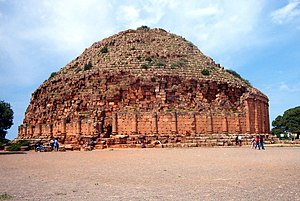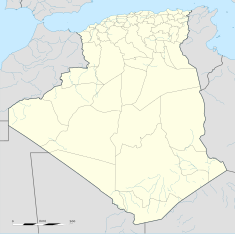Royal Mausoleum of Mauretania
| Royal Mausoleum of Mauretania | |
|---|---|

Mausoleum of Mauretania.
|
|
| Location | Tipaza Province, Algeria |
| Coordinates | 36°34′29″N 2°33′12″E / 36.57472°N 2.55333°ECoordinates: 36°34′29″N 2°33′12″E / 36.57472°N 2.55333°E |
| Built | 3 BC |
| Architectural style(s) | mausoleum |
The Royal Mausoleum of Mauretania is a funerary monument located on the road between Cherchell and Algiers, in Algeria. The Mausoleum is the tomb where the Berber King Juba II and Queen Cleopatra Selene II, sovereigns of Mauretania, are buried.
The sepulchre is sometimes known as the Mausoleum of Juba and Cleopatra Selene. In French, it is called the Tombeau de la Chrétienne ("the tomb of the Christian woman") because there is a cross-like shape of the division lines on the false door. In Arabic, the mausoleum is called the Kubr-er-Rumia or Kbor er Roumia, which means the tomb of the Roman woman. When the Umayyad Caliphate first spread its influence in the Maghreb, its forces used to call people or places that they conquered Rûm, "Roman", after the Eastern Roman Empire.
The mausoleum was built in 3 BC by the last King of Numidia, and later King of Mauretania, Juba II, and his wife Cleopatra Selene II. Cleopatra Selene II was an Egyptian Greek Ptolemaic princess, the daughter of the Queen Cleopatra VII of Egypt and Roman Triumvir Mark Antony. Through her marriage to Juba II, she became the last Queen of Numidia and later Queen of Mauretania.
The mausoleum is probably the Royal Tomb that the 1st-century Roman geographer Pomponius Mela (1.31) described as the monumentum commune regiae gentis ("the communal mausoleum of the royal family"). If the geographer’s description of the mausoleum is correct, then the building was not intended just for Juba and Cleopatra, but envisaged as a dynastic funeral monument for their royal descendants.
...
Wikipedia

